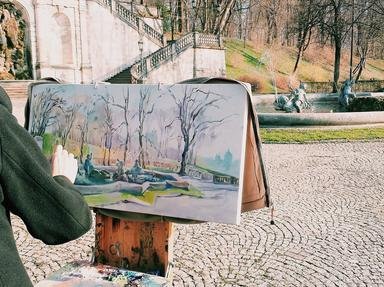Quiz Answer Key and Fun Facts
1. The master of masters, Raphael, created from 1508 to 1511 the massive historical painting that we have come to know as 'The School of _____'. Which illustrious ancient city fits the title?
2. One of my favorites from the 17th century Dutch master Rembrandt is his 'The Raising of _______', which he painted rather early in his career (c. 1630). Whose name is required to complete the title of this popular subject in art history?
3. Grant Wood, one of the most celebrated early 20th century American painters, is widely recognized for his most significant work, known as 'American ______'. What word completes the title of his renowned 1930 piece?
4. There are so many wonderfully delicate works by 19th century French painter Jean Auguste Dominique Ingres that it is difficult to choose just one. For the sake of this quiz I have done so, selecting 'The Bather of _______', one of his most superb nudes, painted in 1808. Fill in the blank by selecting where the bather is from.
5. No series of art quizzes would be complete without mention of a painting from Hieronymous Bosch. And naturally, I would select my favorite by the 15th-16th century Dutch master, namely 'The Garden of ____________'. Please complete the title of this masterwork with the correct two words.
6. It seems we'll be going heavy on the Dutch today, though we won't call it Dutch treat (I'm buying.) One of Vermeer's most lovely paintings, a tiny portrait of a servant woman painted c. 1660, is called 'The ______ Maid'. What sort of maid was this gentle lady?
7. Oskar Kokoschka, one of the key members of the German Expressionist movement, painted a number of moving works. None more moving, however, than his self-portrait entitled 'Portrait of a(n) ________ Artist'. What unexpected word fits the title of this 1937 Kokoschka work?
8. How might we complete the title of Richard Hamilton's pop art collage, created in 1956, that goes, 'Just What is it That Makes Today's Homes So Different, ________?'
9. Renaissance artist Andrea Mantegna painted several magnificent versions of the suffering 'Saint ______', most importantly one early in his career (1459) and two much later (1480, 1490). Which Catholic saint was the topic of Mantegna's apparent fascination?
10. Probably the most well-known work from Thomas Gainsborough, 18th century English portrait and landscape painter, was his 1770 work 'The ___ Boy'. What color was this young chap, as depicted by Gainsborough?
Source: Author
thejazzkickazz
This quiz was reviewed by our editing team before going online.
Any errors found in FunTrivia content are routinely corrected through our feedback system.

